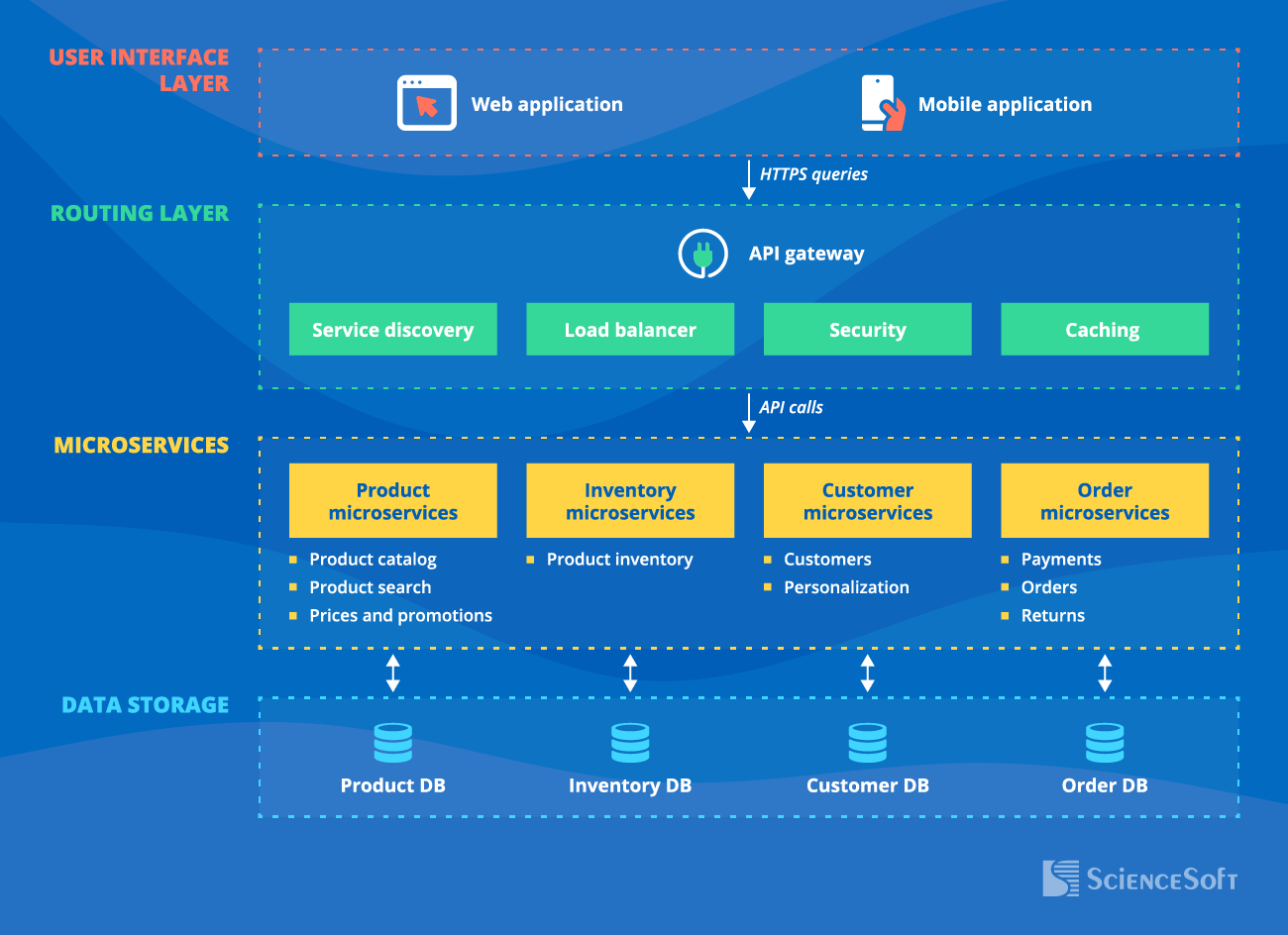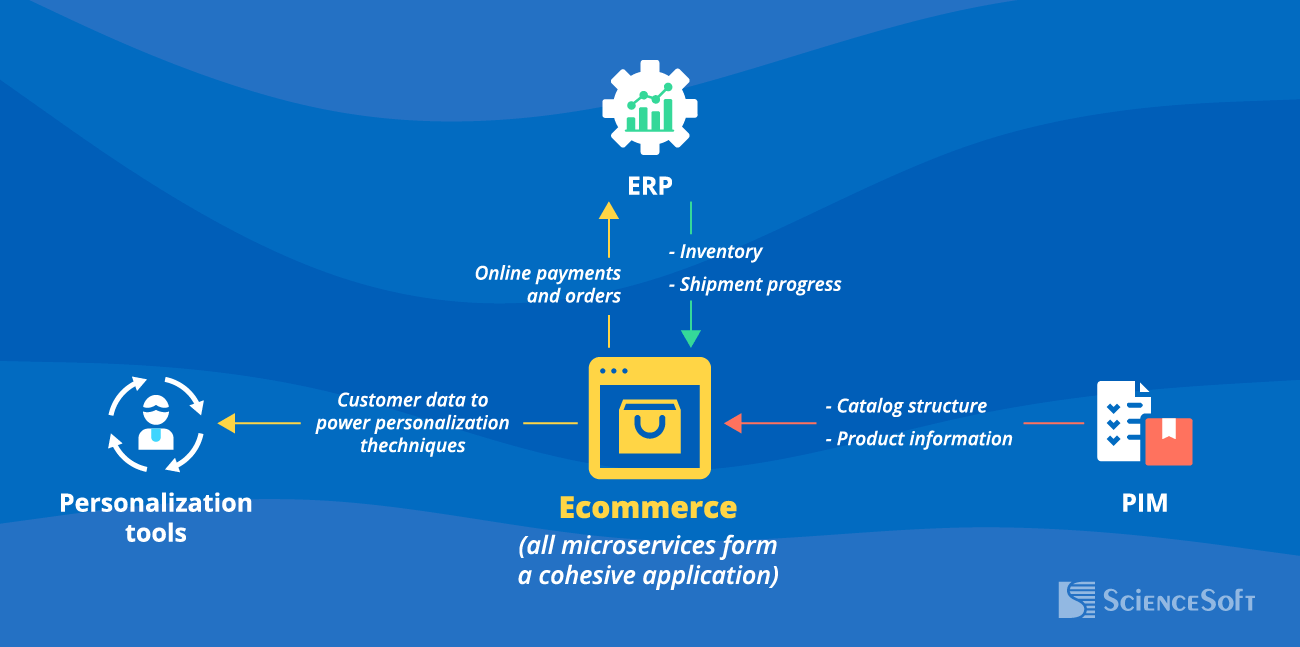Microservices-Based Architecture in Ecommerce
Guide to modular ecommerce solutions
At ScienceSoft, we successfully employ microservices architecture pattern to deploy scalable and high-performing software solutions.
Microservices in Ecommerce
A microservices architecture is used to create ecommerce applications as an assembly of separate components, or microservices, connected via REST APIs. Multiple user interfaces can be built using the same microservices on the back end. Though peculiarities of this architectural approach are of major interest to development teams, its benefits for businesses are numerous:
|
|
Development is not restricted by a rigid technology stack of a monolithic ecommerce platform and can use modern techs. This helps deliver beautifully designed and fast ecommerce applications. |
|
|
Small development teams can work simultaneously to build different services for fast application implementation and market entry. |
|
|
Migration to a modular ecommerce architecture is investment in installments. You can rebuild and modernize your ecommerce solution step-by-step, by replacing each business function with a microservice. You can start with areas where custom workflow or design can influence customer experience and thus sales the most. |
|
|
It’s easier and less costly to scale a microservices-based ecommerce application because each service lives through its own life cycle – it’s created, modified, tested and removed (if needed) independently from other services. This is beneficial for growth-oriented companies that are planning to invest and evolve their ecommerce presence gradually. |
|
|
Ecommerce applications (and hence online sales) are more resilient as malfunctions in a single microservice don’t disrupt the whole application. |
|
|
The infrastructure cost can be optimized as microservices are cloud-native, and each service can be hosted on a different cloud instance based on its bandwidth requirements. |
Microservices Architecture
When building microservices-based ecommerce applications, ScienceSoft works with the main architecture layers and components as described. Synchronous communication between microservices will be organized via API and asynchronous communication between microservices will be organized via Message Bus.
Sample architecture with core ecommerce microservices

User interface layer
Is used to create multiple digital customer touchpoints using the same microservices on the back-end.
Routing layer
Connects HTTPS queries to corresponding microservices.
- API gateway creates APIs at any scale.
- Service Discovery finds dynamically assigned network locations of microservices instances.
- Load Balancer distributes API calls among microservices.
- Caching stores and returns static data (e.g., text files) to upload web pages faster.
- Security safeguards microservices from external threats.
Container ecosystem
Stores units of microservices.
- Microservices are built around certain business context: data type, responsibility, function.
Data storage layer
Each cluster of microservices manages its own data.
The Role of Automation in Microservices Delivery
When talking about microservices, our experienced software architects always stress the importance of a proper automation strategy that relies on DevOps practices and test automation.
CI/CD pipeline
All microservices are packaged, tested and deployed in the same manner, so unification of the delivery pipeline propels fast progress in the ecommerce application creation.
Testing automation
Each microservice with its dependencies should be tested separately, and the number of microservices may easily exceed 100. The use of automated tests during microservices testing is a way to speed up the application deployment.
Container orchestration tools
All microservices are containerized. Tools like Docker and Kubernetes help with automated simultaneous deployment in multiple containerized environments. For example, with a one-line command in Kubernetes, one can introduce a required update to dozens and hundreds of microservices.
A multicloud strategy
One can employ several cloud vendors to optimize infrastructure cost and minimize the risk of overload of a single resource. In this case, a DevOps team must standardize the management of several clouds, monitor the availability, performance and security of cloud environments.
How to Migrate from Monolithic to Modular Architecture

Migration tips from ScienceSoft
|
|
Define the bounded context of microservices to decompose your ecommerce application. The context can be based on the type of information microservices will deal with, e.g., Order service to manage orders, or an action, e.g., Wish list service responsible for adding items to wish list by a user’s click. |
|
|
Don’t make microservices too small not to overcomplicate the structure. If you doubt, you can start with larger services and split them later if needed. |
|
|
The very idea of a microservices-based architecture implies having a separate database for each service. You can split a monolithic database by:
|
|
|
When dealing with database splitting, you will also have to locate data that will be used by many microservices, e.g., supported currencies. We recommend developing a separate microservice to manage such data and provide it to API calling microservices. |
|
|
The database-per-microservice architecture means that data from multiple databases needs to be aggregated for data analytics and reporting. The simplest way to do that is to put in place a data analytics engine that will collect data from corresponding databases via APIs. Alternatively, you can have data pumps that enable high-speed movement of data from different source databases into the data analytics engine. |
|
|
Use monitoring tools to control the performance of microservices and alert on malfunctions. |
Engage team players with different expertise and background
Each case of microservices-based architecture development for ecommerce is individual. There is no universal set of tools that would allow getting all the benefits the microservices architecture can bring. What you need at the start is a cross-functional team, proficient in designing stable, scalable and high-performing distributed architectures, to code each individual microservice and assemble them all into a coherent ecommerce application.
Useful Third-party Integrations
Along with an API-based inner structure, ScienceSoft always provides external APIs to connect an ecommerce application to third-party systems. For ecommerce operations, we recommend to integrate a web application with:
- ERP (Enterprise Resource Planning system) to streamline the exchange of information between a company’s different units (e.g., finance department, warehouses).
- PIM (Product Information Management system) to collect holistic information about products and push it online (also to non-digital sales channels in case of multi-channel retail environment).
- Personalization tool to increase the return from marketing initiatives, to position the brand as caring about customers’ time and knowing their habits.

Ready to Put Theory into Action? Engage ScienceSoft!
ScienceSoft is a software development provider experienced in building custom ecommerce solutions, both monolithic and modular. In our team of 750+ IT experts, there are experienced software architects working with microservices and containerization environments. We can help you with:
Architecture planning
We will help you plan a distributed environment of microservices and inter-service communication to ensure the best fault isolation and autonomous service management.
Microservices development
By working in autonomous development teams, we will create your ecommerce application as a set of independently deployed microservices fast.
Migration to microservices
We will split your monolithic ecommerce application into microservices and gradually migrate all business functions to ensure a possibility to evolve your app more freely and faster.
Our client talks about the benefits of microservices implemented by ScienceSoft
We’re always looking to enhance our solutions with new features that meet the customers’ most demanding needs. ScienceSoft’s developers used the microservices approach to ensure the system’s scalability, which is critical for us as our user base is growing. They selected and implemented techs that ensured the system’s availability and fault-tolerance in the future.
Wadih Pazos, Chief Operating Officer, Paramount WorkPlace
Our technology portfolio
You Might Want to Ask
How much does it cost to develop an ecommerce solution with microservices-based architecture?
On average, the implementation cost of a microservices-based ecommerce solution ranges between $100,000 and $200,000. We need to know your precise requirements to give an accurate estimate.
What are approximate implementation timelines?
The development of a microservices-based ecommerce solution takes at least 6-8 months. Large-scale projects may last longer.
What's the difference between monolithic and microservices ecommerce architecture?
A monolithic ecommerce application is designed as a single service. All layers of an application reside in a single codebase and are tightly connected. If you introduce any changes, you need to redeploy the whole application.
A microservices ecommerce application is designed as a collection of separate services responsible for different business functions. Microservices are connected via APIs. You can change and deploy services independently.
How to move from monolithic architecture to microservices?
The migration from monolithic to modular architecture is stepwise. We decompose an application into separate functions and split the codebase into microservices accordingly. We link each microservice to a relevant database and set up a data analytics engine to aggregate application-wide data. We incrementally replace the monolith with microservices.




